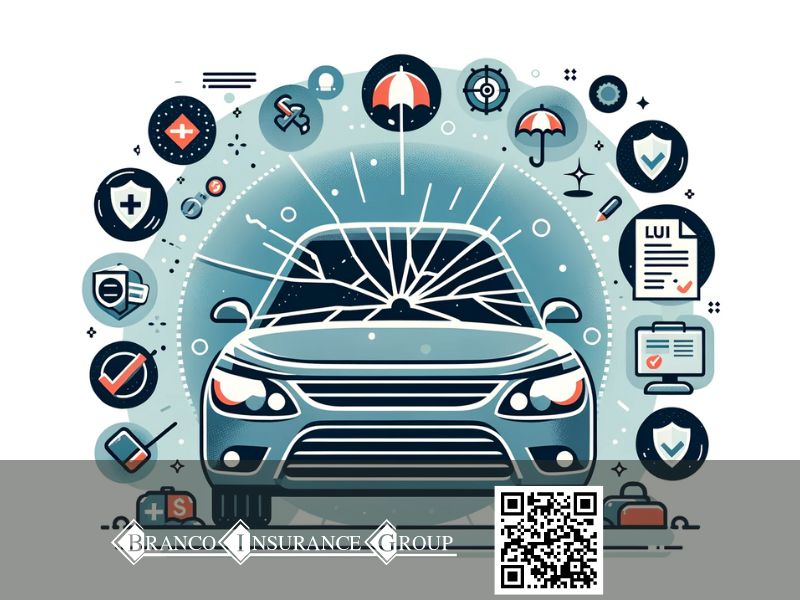Driving around with a cracked or damaged windshield can be dangerous. Not only does it obstruct your view of the road, but it compromises the structural integrity of your vehicle in the event of a collision. That’s why having adequate auto glass coverage through your auto insurance policy is so important.
This guide will explain everything you need to know about auto glass insurance coverage – what it is, what it covers, how to file a claim, and tips for getting the right protection. We’ll also overview key terminology, state laws, and provide answers to some frequently asked questions.
Key Takeaways
- Auto glass coverage helps pay for windshield and other glass repairs or replacements through insurance. Comprehensive policies and full glass add-ons provide this protection.
- Comprehensive coverage pays for non-collision glass damage like weather, vandalism, animals, and road debris but you pay your deductible per claim. Full glass waives your deductible.
- Those who benefit most from added glass insurance include high-mileage freeway drivers, owners of expensive vehicles with sensor-equipped glass, and motorists in states lacking $0 deductible laws.
- Windshield damage should be addressed promptly to avoid worsening, visibility issues, and illegal driving. Know when repairs vs full replacement are appropriate.
- Windshield claims are unlikely to raise comprehensive auto insurance rates significantly unless you have an abnormal number of filings. Discuss impact specifics with your provider though.
- Driving with badly cracked or obstructed windshields breaks laws in many states, risking fines of $50+ in most areas. The cracks’ size, placement, and impact on control factor into illegality per location laws.
- Compare top insurers’ options and pricing to find the optimal auto glass coverage for your situation balancing premium costs against vulnerability. Bundling multiple policies can sometimes secure valuable discounts too.
What is Auto Glass Coverage?
Auto glass coverage, sometimes called windshield coverage, refers to insurance that helps pay for windshield and auto glass repair and replacement services. It protects you from having to pay costly windshield replacement or repair bills out-of-pocket.
There are two main types of auto glass coverage:
- Comprehensive coverage: Covers glass damage from non-collision-related incidents like vandalism, weather events, falling objects, and collisions with animals. You pay a deductible when you file a glass claim.
- Full glass coverage: An add-on that often waives your auto glass deductible so you pay nothing for covered glass repairs and replacements. Also called “no deductible glass coverage.”
Without special glass coverage, you’d have to pay all windshield and auto glass repair and replacement costs yourself.
What Does Auto Glass Insurance Cover?
The specifics of what your auto glass coverage protects depend on your policy limits, state laws, and other factors. But in general, comprehensive policies and full glass add-ons cover damage to:
- Windshield
- Side and rear windows
- Sunroofs and moonroofs
- Glass panels
- Mirror glass
Comprehensive auto policies and full glass riders also often cover glass repairs in addition to replacements. So if you just get a small rock chip or crack, your insurer may pay for resin injections or other repairs so you can avoid replacing the entire windshield.
Who Needs Additional Glass Coverage?
While every driver needs liability and collision insurance, not everyone needs special auto glass coverage. Here are some factors to consider when deciding if you should add comprehensive or full glass protection:
- Where you drive: If you frequently drive on gravel roads or highways where road debris can crack glass, additional coverage is smart. Urban drivers are less likely to benefit.
- Your deductible amount: If you have a high comprehensive deductible like $1,000, a full glass rider can save you money in the event of a claim.
- Windshield replacement costs: High-tech windshields with sensors and cameras can cost $1,000+ to replace. Extra coverage gives peace of mind.
- State laws: Florida, Kentucky, and South Carolina require $0 glass deductibles when you have comprehensive coverage. So full glass is unnecessary.
Evaluate your situation to determine if comprehensive or full glass makes sense for your needs and budget. Agents can help explain specifics for your state.
Comprehensive Auto Glass Insurance Coverage
Comprehensive coverage is an optional addition to your auto policy that covers vehicle damage from non-collision-related events beyond your control. This includes:
- Vandalism
- Theft
- Falling objects/road debris
- Weather events like hail storms
- Floods
- Fire
- Collisions with animals
And since it protects against things like road debris cracking your windshield, it covers auto glass damage as well.
Comprehensive glass coverage provides a few key benefits:
- Covers glass repairs and replacements
- Subject to your chosen deductible amount
- Often fully pays for minor repairs like small rock chips
It’s important to note that you will be responsible for paying your comprehensive deductible when you file a glass claim before your insurance covers the remaining cost.
For example:
- Your $500 comprehensive deductible
- $800 windshield replacement
- You pay $500, insurance pays $300
When to File a Comprehensive Glass Claim
You should file a comprehensive claim anytime you suffer auto glass damage from something other than a collision, like:
- Your windshield is cracked from a stray baseball or gravel kicking up from a truck on the highway
- Vandals throw a rock through your side window
- Hail cracks your sunroof
- A fallen tree branch shatters your back windshield
As long as you have documented proof of the damage, like photos or police reports, your insurer will cover the claim minus your deductible.
Full Glass Insurance Coverage
While comprehensive coverage extends to auto glass, full glass coverage provides protection a step above. Also referred to as a no deductible glass rider or zero deductible glass coverage, full glass insurance pays your full windshield or auto glass repair/replacement bill.
Here’s how it works:
- It’s an optional add-on you purchase separately
- Waives your glass deductible when you file a glass-only claim
- You pay $0 out of pocket for covered glass repairs or replacements
So, unlike comprehensive policies that require you to pay the deductible, full glass coverage takes care of the entire bill. This gives you ultimate peace of mind in the event of glass harm.
Full glass coverage/riders cost extra per month. But they can save you money over time if you file any glass claims. No deductible windshield coverage ranges from $2 to $10 extra per month depending on your insurer and policy limits.
Who Needs Full Glass Insurance?
Full glass coverage isn’t necessarily right for everyone. Assess your personal situation and risk factors. Good candidates for no-deductible glass riders include:
High-risk drivers: If you log lots of highway miles or have a cracked windshield history, the extra coverage can pay for itself quickly.
Expensive vehicles: For high-tech windshields or luxury cars with costly glass, full protection brings added peace of mind.
States without $0 glass deductible laws: If you live in a state that lets insurers charge glass deductibles like $500 or $1,000+, full coverage can majorly benefit you.
Review your driving habits, where you live, and windshield replacement costs to gauge if you’d benefit.
How Much Does Windshield Insurance Coverage Cost?
The cost of windshield coverage varies depending quite a bit on factors like:
- Your insurer
- Coverage type
- Policy limits
- Vehicle make, model, and year
- Your driving and claims history
- Where you live
Nationwide averages for windshield insurance are:
- Comprehensive coverage: $339 per year
- Full glass coverage: $2 to $10 per month
So, full glass add-ons cost very little monthly. Comprehensive rates can vary more widely based on the above criteria though.
Compare quotes from multiple top auto insurers to find the best auto glass coverage options and pricing for your situation. Having choices lets you optimize coverage and cost.
Bundled Insurance Savings
An easy way to secure savings on comprehensive or full glass premiums is by bundling multiple policies with the same provider. Most leading insurers offer bundling discounts, which commonly applies to:
The more policies you group together, the deeper discounts you can earn. So bundling allows you to get adequate windshield protection while optimizing value.
Windshield Repair Vs. Replacement
When auto glass sustains damage, you typically have two options – repair it or completely replace it. Assessing the severity of damage is key to choosing the best route forward.
When to Repair a Windshield
Small rock chips, cracks under 6 inches, and damage away from the driver’s sightline can often be effectively repaired. Benefits include:
- Far cheaper than replacement (often free with insurance)
- Prevents existing damage from worsening
- Avoid time without a vehicle
- Maintain use of original factory glass
When You Must Replace a Windshield
Larger cracks over 6 inches, damage within the driver’s critical sightline, or complex shatters typically require total windshield glass replacement. Signs it’s time to replace include:
- Large branching cracks
- Cracks originating from the edge of the glass
- Obstructed driving visibility
- Evidence the glass integrity is compromised
Replacing just a windshield (without sensors) can cost $250 to $400 on average. Prices range higher for luxury, specialty, and sensor-equipped glass. Know when to repair vs replace to minimize expenses and safety risks.
How Insurance Claims Affect Your Auto Policy
An important question many drivers have is whether filing an auto glass insurance claim will increase their car insurance rates. The answer is generally no – windshield replacements are unlikely to impact your premium.
Here’s why:
- Windshield claims fall under comprehensive coverage, which factors minimally into rate increases compared to at-fault accidents.
- Insurers understand cracked glass happens somewhat commonly and isn’t always something within policyholder control.
- State laws also restrict premium hikes following not-at-fault comprehensive claims.
However, exceptions exist in a couple of scenarios:
- You file multiple glass claims in a policy period – then insurers may deem you high risk.
- Dropped glass coverage discounts may impact pricing.
Overall though, single windshield repairs/replacements shouldn’t drive rate hikes. Discuss specifics with your insurance provider for more clarity.
Is Driving with a Cracked Windshield Legal?
You absolutely shouldn’t drive with severely cracked or damaged glass due to the safety hazard it poses. But at what point does it become illegal? The answer depends on your state laws.
In general, it’s illegal to operate a vehicle if damage significantly obstructs the driver’s sightlines or view of mirrors/gauges. States like California expressly prohibit driving with damage that “impairs the driver’s clear vision.”
Rules on cracked windshield legality tend to focus on:
- Size of cracks/chips: Medium to large damage often exceeds legal limits. Texas rejects windshields with star breaks bigger than 1.5 inches.
- Location of damage: Central or sightline-blocking cracks frequently run afoul of laws.
- Impact on control/safety: If damage realistically compromises vehicle safety, it’s typically prohibited.
Fines for driving with badly cracked glass range from $50 to a few hundred dollars in most states. Rather than risk legal issues or accidents, repair or replace damaged windshields promptly.
Why Windshield Damage Matters
It’s easy to downplay minor glass chips and cracks. But even superficial-seeming damage has real consequences:
- Weakens windshields – Further impacts worsen damage.
- Degrades driver vision – Impairs visibility creating accident risk.
- Harms vehicle control – Cracks can inhibit windshield wipers or sensors.
- Often spreads over time – Small damage grows into major issues.
- Illegal in many states – Can prompt fines.
Don’t take windshield damage lightly. Get comprehensive insurance coverage so you can repair problems right away and drive safely.
5 Common Windshield Damage Scenarios
Windshields crack and chip more often than you might think. While every situation is unique, a few prevalent causes of glass damage exist. Stay aware of these common culprits:
- Road debris: Fallen items, loose gravel, stirred-up rocks – all can chip glass. This accounts for over 75% of damage per insurer jjgt5r.
- Extreme weather: Hail storms with high-velocity projectiles frequently harm windshields. Also, blizzards and debris blowing in high winds.
- Vandalism: While less common in relation to random roadway debris, vandals still damage approx. 500,000 car windshields annually.
- Vehicle accidents: Major crashes as well as minor bumps/collisions sometimes crack glass. This falls under collision rather than comprehensive policies.
- Improper installation/materials: Cheap aftermarket windshields or faulty replacement work occasionally necessitate rapid fixes when glass fails.
No matter how damage occurs, having adequate auto glass insurance that aligns with potential risks provides essential protection.
Table 1: Auto Glass Laws by Some States
State | $0 Glass Deductible Mandated? | Inspection Rules | Tint Restrictions |
Florida | Yes | Cracks causing view obstruction fail inspection | None on windshields |
Kentucky | Yes | No statewide inspections | Windshield tint must allow 70% light transmittance |
South Carolina | Yes | No statewide inspections | Certain windshield top tinting allowed |
Texas | No | Cracks over 1.5 inches and wiper interference prompt inspection failure | Windshield tint must have over 75% VLT |
California | No | Cracks “obstructing driver vision” explicitly prohibited while driving | Aftermarket tint must not excessively reduce visibility |
Connecticut | No | Cracks over 3 inches cause inspection failure if in driver sightline | Windshield tint darkness cannot exceed certain visibility thresholds |
Factors That Influence Windshield Replacement Costs
Not all windshield replacements cost the same. Several key factors cause pricing variances:
Vehicle make and model – Some vehicles have more complex windshield shapes and features that are costly to replicate. Luxury cars also tend to use higher-grade glass.
Factory vs. aftermarket glass – OEM factory glass is often pricier than basic aftermarket windshield alternatives. Factory matches are important if you have fancy technology.
Sensor recalibration – Vehicles with advanced driver aids like cameras and sensors usually require professional post-replacement recalibration. This alone can exceed $1,000.
Shop location – Urban area repair facilities may charge higher labor rates and fees for materials.
Insurance deductible – If you choose a higher deductible, more out-of-pocket expenditure applies per windshield claim.
Compare options accounting for these influencing variables unique to your situation and car. Cheaper isn’t necessarily better if replacements seem too good to be true.
How Insurance Providers Cover Windshield Damage
While all leading insurers cover vehicle windshield damage under comprehensive policies, some crucial intricacies exist between providers:
Geico – Offers comprehensive protection with typical deductibles. Policyholders can use any licensed glass repair shop without referrals.
Progressive – Comprehensive plans available. $0 glass deductible riders are offered in select states. Approved glass shop networks utilized to control claim costs which policyholders must use.
State Farm – Features standard comprehensive windshield coverage alongside collision insurance. Like Geico, allows customers to independently choose any certified repair facility.
Allstate – Sells comprehensive with competitive glass protection. Allstate auto glass coverage includes complimentary roadside assistance which can help after glass damage makes vehicles undrivable.
When comparing auto policies, clarify details around glass repairs/replacements. Insurer approaches impact policyholder choice freedom and out-of-pocket claim expenses.
Auto Glass Insurance Coverage in Connecticut
Connecticut laws and requirements surrounding windshield replacement insurance differ somewhat from other states. As a Connecticut driver, key things to know include:
Comprehensive protection is essential – Connecticut mandates policyholders carry comprehensive coverage alongside collision insurance on vehicles financed through loans/leases. So most CT drivers already have baseline glass coverage.
Insurers allow glass deductibles – Unlike FL, KY, and SC, Connecticut doesn’t prohibit insurers from charging auto glass deductibles with comprehensive protection. Expect fees with repairs/replacements.
Damage must be safety-impacting for claims – CT restricts using comprehensive insurance for glass damage unless it meaningfully impairs visibility, vehicle control, or ability to pass safety inspections. Purely cosmetic issues aren’t covered.
State safety inspections check glass – Cracks over 3 inches long in driver sightline areas prompt inspection failure. So properly fix these promptly.
Tints cannot excessively reduce light transmittance – Window tint darkness laws apply to windshields too – only certain top sections can have over 35% VLT tinting.
Connecticut drivers need smart glass coverage, but state nuances apply. Inspect policies closely, understand repair vs replacement criteria, and keep safety top of mind if windshield damage occurs.
Table 2: Average Windshield Replacement Costs by Vehicle Type
Vehicle Type | Average Replacement Cost |
Basic vehicles (non-luxury sedans, basic trucks) | $250 – $400 |
Luxury vehicles (Mercedes, BMW, etc) | $400 – $800 |
Vehicles with sensors (cameras, radar, etc) | $1,000+ |
The Bottom Line
Driving with cracked auto glass is extremely unsafe. It also commonly violates state laws. That’s why having insurance that helps pay for windshield repairs and replacements is so valuable.
Review the windshield insurance coverage options in your auto policy. Determine if adding robust protection through comprehensive coverage or full glass riders could benefit you based on your driving environment and budget.
Streamline claims filing if the unfortunate need ever arises leveraging insurers’ and repair shops’ expertise. With the right insurer by your side and adequate precautions, you can get back on the road worry-free even after glass damage.
Final Thoughts On What You Need to Know About Auto Glass Insurance
At Branco Insurance Group, our goal is to provide Connecticut families and businesses with the protection they need. We offer a wide range of insurance products to fit your unique needs, including home, auto, business, and more.
As an independent agency, we have the flexibility to work with multiple highly-rated insurance carriers to find you the right coverage at a competitive price. We combine this with exceptional local service – getting to know you, understanding your risks and assets, and crafting customized solutions.
Whether you’re looking to insure your home, automobile, business, health, or something else entirely, we’re here to help. Contact us for a consultation today to discuss your situation. We’ll evaluate your risks, assets, budget, and goals to put together policy recommendations designed to give you security and peace of mind.
Our experienced team truly cares and we’re committed to your success. We’ve helped countless Connecticut families and businesses just like yours protect what matters most. We’re confident we can do the same for you too. Reach out today to get started.





